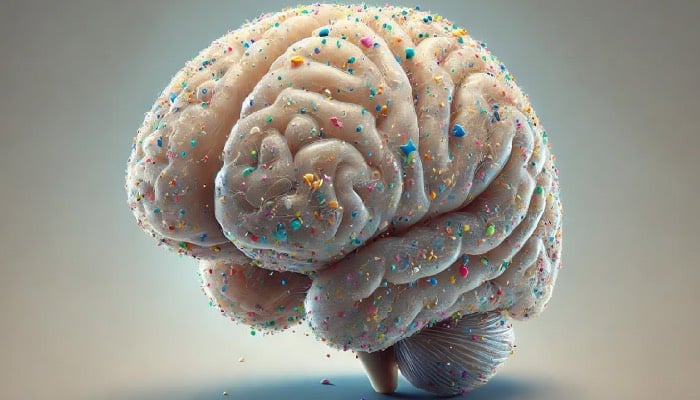According to a recent study that was published on Monday in the journal JAMA Network Open, researchers in Brazil discovered microplastics in the brain tissue of cadavers.
Recent years have seen an increase in research that has discovered microplastics in almost every organ in the body, the blood, and the plaque that clogs arteries. Researchers’ main worry has been whether these common contaminants may enter the human brain.

The olfactory bulb, a region of the brain that processes information about scent, was the focus of the most recent study. One olfactory bulb is located above each nasal cavity in humans. The olfactory nerve runs from the nasal cavity to the olfactory bulb.
Beyond the olfactory bulb, some researchers are concerned that the olfactory pathway might serve as a gateway for microplastics entering the brain.
Lead study author Dr. Thais Mauad, an associate professor of pathology at the University of São Paulo Medical School in Brazil, said, “We think the olfactory bulb is probably one of the first points for microplastics to reach the brain.” Previous studies in humans and animals have shown that air pollution reaches the brain, and that particles have been found in the olfactory bulb.
Mauad collected samples of olfactory bulb tissue from fifteen cadavers of individuals who passed away between the ages of thirty-three and one hundred. Microplastics, which are minuscule plastic particles with sizes ranging from 5.5 to 26.4 micrometers, were found in samples taken from eight of the cadavers.
In all, 16 plastic threads and particles were discovered by the researchers within the tissues. The tiniest ones had a diameter of only 8 micrometers, which is less than that of a human red blood cell. Polypropylene was the most prevalent kind of plastic they discovered, followed by nylon, polyamide, and polyethylene vinyl acetate.
Mauad stated, “Propylene is everywhere—in clothes, rugs, and furniture.” “We are aware that indoors is where we are most exposed to particles due to the abundance of plastic in our homes.”
Microplastics in the brain have been researched by University of New Mexico toxicologist Matthew Campen, who noted that the existence of microplastics in the olfactory bulb “is unique but not terribly surprising.”
In an email, Campen stated, “The nose is a major point of defense to keep particles and dust out of the lungs.” “It is therefore entirely expected to find certain plastics in the olfactory system, especially considering their widespread presence throughout the body.”

Although not included in the report, Campen said he thinks the samples probably also had a large amount of nanoplastics, which are particles with sizes between one and one thousand nanometers. Human DNA strands have a thickness of around 2.5 nanometers. (A micrometer has a volume 1,000 times that of a nanometer.)
The olfactory bulb contains microplastics, but this does not imply that other parts of the brain, such as those involved in cognition, also include microplastics. It’s still unclear if these particles can truly get past the olfactory bulb and enter certain brain regions.
“The olfactory bulb may be a pathway for very small airborne particles to reach the brain, but this is not known to be a major route of material trafficking to the brain,” Campen stated.
The olfactory system serves as the brain’s and nose’s communication channel. By analyzing the minuscule odor molecules that emanate from different items, like freshly baked bread or a bouquet of flowers, the system is able to identify odors. These chemicals cause olfactory neurons to fire, and the brain interprets this stimulation as scent. These paths can be used by additional particles. Even though they are uncommon, amoebas that are bigger than the microplastics discovered in the research, such Naegleria fowleri, can enter the brain through the olfactory nerve.
According to Mauad, “we reasoned that microplastics might be able to pass through this pathway if bacteria can.”
According to Campen, the circulation, which absorbs plastic particles from the lungs or digestive system, is more likely than the olfactory bulb to be the route by which nanoplastics reach the brain. Particles, including those found in medications, find it very difficult to pass through the bloodstream and reach the brain. This is due to the blood-brain barrier, a semipermeable membrane that encircles the brain. The body’s ability to absorb microplastics is currently being studied, and it is yet unclear if these tiny plastic particles can cross the blood-brain barrier in humans.
Animal research have provided the majority of the knowledge that scientists have about the potential health risks associated with the 4,000 chemicals required to produce plastic and the materials themselves. According to a recent study, mice’s brains underwent cognitive alterations after being exposed to microplastics in their drinking water for three weeks. Additionally, the particles might pass across the blood-brain barrier.
The first study to show a correlation between microplastic levels in arterial plaque and increased death rates in such individuals was conducted earlier this year.
Not engaged in the study, Dr. Mary Johnson is an environmental health research scientist at Harvard T.H. Chan School of Public Health. “We know there is an inflammatory reaction when cells are exposed to microplastics in the lab.”
Johnson pointed out that exposure to air pollution has been connected to neurological conditions including dementia.
“It is thought that microplastics might be a piece of the puzzle,” the speaker stated. “The presence of additives in those plastics—some of which we know may be hazardous—raises concerns in addition to the particle itself.”





